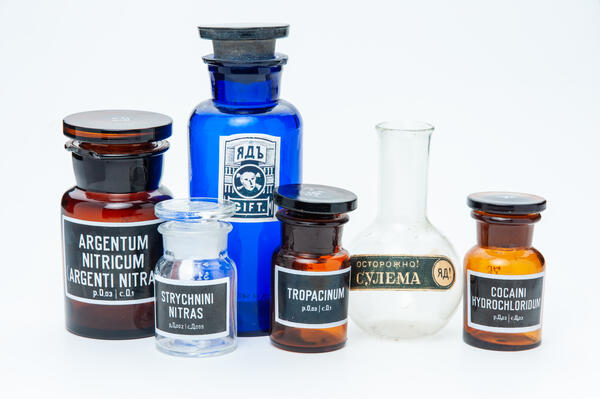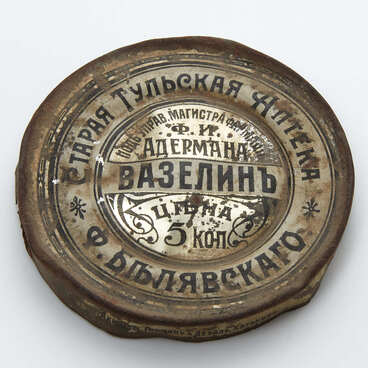Ancient and medieval doctors believed that medicines containing poisonous components were especially effective. As a result of taking such drugs, a person received mild poisoning, he was sick, vomited, and had diarrhea. All this, according to the doctors, helped to cleanse the body of putrefactive elements and contributed to a speedy recovery.
The exhibition presents Soviet glass-stoppered bottles, which were found in the utility rooms of the building. Until recently, these poisons were used in pharmacies in the preparation of prescription drugs.
Silver nitrate is also called lapis imperialis, lunar caustic, ‘infernal stone’. This substance has a bactericidal effect. Medications based on silver compounds treat inflammatory and festering skin, eyes, and throat diseases. Ointment with silver nitrate is prescribed for cauterization of warts, removal of neoplasms. A lapis pencil, which has an epithelizing, bactericidal, and anti-inflammatory effect, is especially popular.
Silver nitrate is also indispensable when developing film photos. It is used as part of the black-and-white images developer. Silver-containing reagents allow one to get a high degree of sharpness of the negative image along with a uniform neat granularity of the photo. It was in pharmacies that photographers of the late 19th — early 20th century bought the necessary substances.
Strychnine is obtained from a ratsbane (poison nut), a broadleaved tree that grows in India and Southeast Asia. In small doses, strychnine works as a short-term stimulant. It blocks the action of glycine, a substance that is involved in neuromuscular transmission. In large doses, strychnine causes painful muscle spasms, which can lead to seizures, respiratory arrest, and death. In the 19th century, medical students used strychnine as a means to combat drowsiness. Until the 1950s of the 20th century, athletes took it as doping. Strychnine was also used to make medicines to improve male potency. In the 19th — 20th centuries, tonic drinks with strychnine were produced: ‘Fellowe’s Syrup’, ‘Easton’s Syrup’, ‘Metatone’. The popularity of strychnine faded by the 1970s. However, still, extract of nux vomica is used in homeopathy.
In the 19th century, arsenic drugs were used to treat fever, stomach pain, heartburn, rheumatism, sleeping sickness, and ‘swamp fever’ (malaria). It was also believed that arsenic helps to dissolve cancerous tumors. In 1786, the doctor Thomas Fowler created a solution with a 1% content of potassium arsenate and a lavender fragrance. Patients who took Fowler’s solution quickly became rosy-colored, because arsenic dilated capillary tubes, and acquired a deceptively fresh complexion.
Medicines made of mercury and its derivatives have been popular at all times. The healer Paracelsus was of opinion that mercury, salt, and sulfur can cure most ailments. Corrosive sublimate — mercuric chloride — was used to treat lichen, and mercuric cyanide — as a disinfectant.
The exhibition presents Soviet glass-stoppered bottles, which were found in the utility rooms of the building. Until recently, these poisons were used in pharmacies in the preparation of prescription drugs.
Silver nitrate is also called lapis imperialis, lunar caustic, ‘infernal stone’. This substance has a bactericidal effect. Medications based on silver compounds treat inflammatory and festering skin, eyes, and throat diseases. Ointment with silver nitrate is prescribed for cauterization of warts, removal of neoplasms. A lapis pencil, which has an epithelizing, bactericidal, and anti-inflammatory effect, is especially popular.
Silver nitrate is also indispensable when developing film photos. It is used as part of the black-and-white images developer. Silver-containing reagents allow one to get a high degree of sharpness of the negative image along with a uniform neat granularity of the photo. It was in pharmacies that photographers of the late 19th — early 20th century bought the necessary substances.
Strychnine is obtained from a ratsbane (poison nut), a broadleaved tree that grows in India and Southeast Asia. In small doses, strychnine works as a short-term stimulant. It blocks the action of glycine, a substance that is involved in neuromuscular transmission. In large doses, strychnine causes painful muscle spasms, which can lead to seizures, respiratory arrest, and death. In the 19th century, medical students used strychnine as a means to combat drowsiness. Until the 1950s of the 20th century, athletes took it as doping. Strychnine was also used to make medicines to improve male potency. In the 19th — 20th centuries, tonic drinks with strychnine were produced: ‘Fellowe’s Syrup’, ‘Easton’s Syrup’, ‘Metatone’. The popularity of strychnine faded by the 1970s. However, still, extract of nux vomica is used in homeopathy.
In the 19th century, arsenic drugs were used to treat fever, stomach pain, heartburn, rheumatism, sleeping sickness, and ‘swamp fever’ (malaria). It was also believed that arsenic helps to dissolve cancerous tumors. In 1786, the doctor Thomas Fowler created a solution with a 1% content of potassium arsenate and a lavender fragrance. Patients who took Fowler’s solution quickly became rosy-colored, because arsenic dilated capillary tubes, and acquired a deceptively fresh complexion.
Medicines made of mercury and its derivatives have been popular at all times. The healer Paracelsus was of opinion that mercury, salt, and sulfur can cure most ailments. Corrosive sublimate — mercuric chloride — was used to treat lichen, and mercuric cyanide — as a disinfectant.


